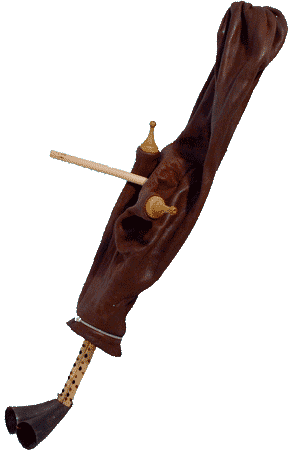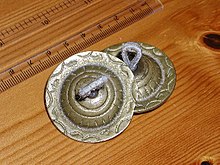
Bagpipes are a woodwind instrument using enclosed reeds fed from a constant reservoir of air in the form of a bag. The Great Highland bagpipes are well known, but people have played bagpipes for centuries throughout large parts of Europe, Northern Africa, Western Asia, around the Persian Gulf and northern parts of South Asia.

The chanter is the part of the bagpipe upon which the player creates the melody. It consists of a number of finger-holes, and in its simpler forms looks similar to a recorder. On more elaborate bagpipes, such as the Northumbrian bagpipes or the Uilleann pipes, it also may have a number of keys, to increase the instrument's range and/or the number of keys it can play in. Like the rest of the bagpipe, they are often decorated with a variety of substances, including metal (silver/nickel/gold/brass), bone, ivory, or plastic mountings.

The great Highland bagpipe is a type of bagpipe native to Scotland, and the Scottish analogue to the great Irish warpipes. It has acquired widespread recognition through its usage in the British military and in pipe bands throughout the world.

In Arabic music, a mizmār is any single or double reed wind instrument. In Egypt, the term mizmar usually refers to the conical shawm that is called zurna in Turkey and Armenia.

The davul, dhol, tapan, atabal or tabl is a large double-headed drum that is played with mallets. It has many names depending on the country and region. These drums are commonly used in the music of the Middle East and the Balkans. These drums have both a deep bass sound and a thin treble sound due to their construction and playing style, where different heads and sticks are used to produce different sounds on the same drum.
Berber music refers to the musical traditions of the Berbers, a diverse grouping of distinct ethnic groups indigenous to North Africa who predate the arrival of Arabs in the Arab migration to the Maghreb. Their main connections are identified by their usage of the mostly mutually unintelligible Berber languages. Berber music varies widely across North Africa. It is stylistically diverse, with songs being predominantly African rhythms and a stock of oral literature.

Tahtib is the term for a traditional stick-fighting martial art originally named fan a'nazaha wa-tahtib. The original martial version of tahtib later evolved into an Egyptian folk dance with a wooden stick. It is commonly described in English as a "stick dance", "cane dance", "stick-dancing game", or as ritual mock combat accompanied by music. Nowadays, the word tahtib encompasses both martial practice and performance art. It is mainly practiced today in Upper Egypt. Tahtib is regularly performed for tourists in Luxor and Aswan.
The term double clarinet refers to any of several woodwind instruments consisting of two parallel pipes made of cane, bird bone, or metal, played simultaneously, with a single reed for each. Commonly, there are five or six tone holes in each pipe, or holes in only one pipe while the other acts as a drone, and the reeds are either cut from the body of the instrument or created by inserting smaller, slit tubes into the ends of the pipes. The player typically uses circular breathing.

The rhaita or ghaita is a double reed instrument from West North Africa, specifically Morocco, Algeria and Mauritania. It is nearly identical in construction to the Arabic mizmar and the Turkish zurna. The distinctive name owes to a medieval Gothic-Iberian influence. In southern Iberia, various sorts of wind instruments, including the related shawm, are known as gaitas, but in northern Iberia gaita refers only to bagpipes.

Mezwed is a genre of popular traditional music based on Tunisian scale rhythms. It incorporates traditional North African drums called Darbouka and a kind of bagpipe called a mizwad with a bag made from ewe's leather. Usually, it is sung in Tunisian and Algerian linguistic varieties. Originally the music of the countryside and the working classes; it is often played at weddings and parties.
Līwa is a Khaleeji traditional dance of African origin performed in Eastern Arabia, mainly within communities of descendants of people from the Swahili Coast. It is also performed by the African-descended Sheedi community, as well as the Baloch of Makran Coast and Karachi area.

The mizwad is a type of bagpipes played in Tunisia and Algeria, (in French). The instrument consists of a skin bag made from ewe's leather, with a joined double-chanter, terminating in two cow horns, similar to a hornpipe (instrument).This instrument is played with a single-reed.
The zukra is a Libyan bagpipe with a double-chanter terminating in two cow horns; it is similar in construction to the Tunisian mizwad.

Al-Sirah al-Hilaliyyah, also known as the Sirat Bani Hilal or the al-Hilali epic, is an Arabic epic oral poem that recounts the tale of the journey of the Bedouin tribe of the Banu Hilal from Najd in Arabia to Tunisia and Algeria via Egypt. It is built around historical events that took place in the 11th century. The Banu Hilal were dominant in central North Africa for over a century before their annihilation by the Almohads. The epic is folkloric and oral, not having been committed to writing until relatively recent times, and doesn't have a well-defined date of creation. Of the dozen odd major oral epic poems that developed within the Arab folk tradition between the Middle Ages and the 19th century, Sirat Bani Hilal is today the only one that is still performed in its integral musical form. The longest notable version contains 1,000,000 lines, the poet could sing this version about 100 hours. The epic, once widespread throughout the Middle East, is today performed only in Egypt. In 2008 it was inscribed on UNESCO's Representative List of the Intangible Cultural Heritage of Humanity.
The Brothers of the Baladi is a World music band based in Portland, Oregon, USA, that plays both traditional Middle Eastern music, and also combines traditional Middle Eastern and western sounds and instruments for a unique Worldbeat sound. Band leader/percussionist/vocalist Michael Beach provides lyrics in Arabic, Turkish, Persian, French, Spanish, Kurdish, Armenian and English, and the band features many traditional Middle Eastern instruments including oud, saz, mizmar, midjwiz, arghool, doumbek, riq, def, tar, bendir and davul.

Mezmar or mizmar is a traditional group performance and stick song-dance that is performed by in the Hejaz region in western Saudi Arabia for festive occasions such as wedding and national events. Almezmar is performed by about 15–100 practitioners in festive occasions such as wedding and national events, they twirl long sticks, beat drums and clap to songs that can pertain to a variety of topics such as heroism, praise, chivalry, love and generosity. In the past, the ritual was associated with battle or competition. It closely resembles the tahtib dance practiced in Egypt and Sudan.

Muhieddine Abdul Razzak Itani, also known as Tabello, was a Lebanese footballer who played as a full-back.

Nafir, also nfīr, plural anfār, Turkish nefir, is a slender shrill-sounding straight natural trumpet with a cylindrical tube and a conical metal bell, producing one or two notes. It was used as a military signaling instrument and as a ceremonial instrument in countries shaped by Islamic culture in North Africa, the Middle East and South Asia. In Ottoman, Persian and Mugulin miniatures, the nafīr is depicted in battle scenes. In Christian culture, it displaced or was played alongside of the curved tuba or horn, as seen in artwork of about the 14th century A.D.


















